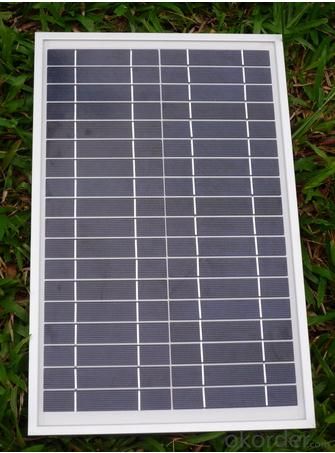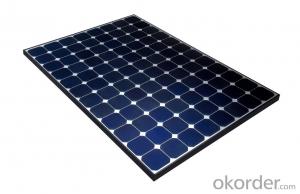200KW CNBM Monocrystalline Silicon Panel for Home Using
- Loading Port:
- Tianjin
- Payment Terms:
- TT OR LC
- Min Order Qty:
- 15 watt
- Supply Capability:
- 1000 watt/month
OKorder Service Pledge
OKorder Financial Service
You Might Also Like
Item specifice
200KW CNBM Monocrystalline Silicon Panel for Home Using
Production description
he price of solar power, together with batteries for storage, has continued to fall so that in many countries it is cheaper than ordinary fossil fuel electricity from the grid (there is "grid parity"). For example in 2015, an average home in Europe or the US could use around 3,000 kilowatt-hour (kWh) in electricity each year.[1] Twelve 280 watt solar PV modules (each generating 250 kWh annually) would generate at least 3,000 kWh each year, even in a cloudy country like the UK. An example market price would be about £8,000 in the UK, $12,000 in the US, or €10,000 in theEurozone in 2015, which is certain to continually fall,[2] allowing permanent energy independence for each household. Most governments have feed-in tariff systems that allow homeowner to sell surplus energy back into the grid, and make a future profit on their investment.Off-the-grid homes are autonomous; they do not rely on municipal water supply, sewer, natural gas, electrical power grid, or similar utility services. A true off-grid house is able to operate completely independently of all traditional public utility services. The idea has been recently popularized by certain celebrities including Ed Begley, Jr.[1] who stars in Living with Ed[2] television show on the Home & Garden Television (HGTV) network. Actress Daryl Hannahpromotes off-grid living and constructed her home in Colorado according to those principles, as does survival expert and Dual Survival co-star Cody Lundin,[3]who lives in a self-designed, passive solar earth house in the high-desert wilderness of Northern Arizona, collecting rainwater, composting waste, and paying nothing for utilities.[4][5]
Electrical power can be generated on-site with renewable energy sources such as solar (particularly with photovoltaics), wind, micro hydro, geothermal; with agenerator or Micro combined heat and power with adequate fuel reserves. Such a system is called a stand-alone power system. In addition, it is possible to simply eliminate electric power such as in Old Order Amish and Old Order Mennonite communities.
Feature
1.High conversion efficiencies resulting in superior power output performance.
2.Outstanding power output even in low light or high temperature conditions
3.Optimized design for ease of soldering and lamination
Physical characteristic
1. Rigorous quality control meets the highest international standards.
2. High-transmissivity low-iron tempered glass, strong aluminium frame.
3. Using UV-resistant silicon.
4. IS09001/14001/CE/TUV/UL
Packaging
26pcs in one carton 6pallets in 20foot container 14pallets in 40 foot container.
- Q:How do solar energy systems impact property values?
- Solar energy systems can have a positive impact on property values. Studies have shown that homes equipped with solar panels tend to sell at a higher price and quicker compared to homes without them. The potential energy cost savings, environmental benefits, and increased desirability of owning a renewable energy source all contribute to the increased value.
- Q:How much space is needed for a solar energy system?
- The amount of space needed for a solar energy system can vary depending on several factors, including the size of the system and the efficiency of the solar panels. On average, a small residential solar system may require around 100-400 square feet of available roof space, while a larger commercial system could require several thousand square feet or even acres of land. It is important to consider factors such as shading, orientation, and local regulations when determining the space requirements for a solar energy system.
- Q:Are there any risks of electrical shock with solar energy systems?
- Yes, there are potential risks of electrical shock associated with solar energy systems. While solar panels themselves do not produce dangerous voltages, the electrical wiring and components used in the system can carry high voltages that may pose a risk if not handled correctly. It is crucial to have trained professionals install and maintain solar systems to ensure proper grounding, insulation, and safety precautions are in place, reducing the risk of electrical shock to a minimum.
- Q:Can solar energy systems be used for powering streetlights?
- Yes, solar energy systems can be used for powering streetlights. Solar panels can be installed on top of streetlight poles or nearby structures to capture sunlight and convert it into electricity. This renewable energy source eliminates the need for traditional electrical connections, making streetlights more energy-efficient and environmentally friendly. Additionally, solar-powered streetlights can function independently, even during power outages, which improves safety and reduces dependence on the grid.
- Q:How do solar energy systems contribute to reducing peak demand on the electrical grid?
- Solar energy systems contribute to reducing peak demand on the electrical grid by generating electricity during the day, when demand is typically highest. This reduces the reliance on conventional power sources during peak times, thus alleviating strain on the grid and potentially avoiding blackouts or brownouts. Additionally, excess solar energy generated during the day can be stored in batteries or fed back into the grid, further reducing peak demand and providing a more stable and sustainable energy supply.
- Q:Can solar energy systems be used in areas with high winds?
- Yes, solar energy systems can be used in areas with high winds. While high winds can potentially affect the efficiency of solar panels, modern solar energy systems are designed to withstand various weather conditions, including strong winds. Additionally, proper installation techniques, such as using sturdy mounting structures and securing panels, can help ensure the durability and functionality of solar energy systems in areas with high winds.
- Q:Can solar energy systems be integrated into building materials, such as solar roof tiles?
- Solar energy systems can indeed be incorporated into building materials, and one popular instance of this is the utilization of solar roof tiles. These tiles, also referred to as solar shingles or solar slates, have been meticulously designed to resemble conventional roofing materials while simultaneously harnessing solar energy. Constructed with photovoltaic cells that convert sunlight into electricity, these specialized tiles have numerous advantages over traditional solar panels. One of the primary benefits of solar roof tiles is their seamless integration with a building's overall aesthetics, resulting in a more visually appealing structure. This harmonious blend into the building's structure allows for a more cohesive design, particularly in regions where stringent architectural guidelines are in effect. Moreover, solar roof tiles can be installed on both new and existing buildings, providing a flexible and adaptable solution. Another advantage of solar roof tiles lies in their ability to generate electricity while exhibiting durability and resistance to harsh weather conditions. These tiles are specifically designed to withstand various elements, including rain, snow, and wind. Additionally, solar roof tiles are typically manufactured using high-quality materials, ensuring a longer lifespan compared to traditional roofing materials. The integration of solar energy systems into building materials, exemplified by solar roof tiles, offers a multitude of benefits. Not only do they generate clean and renewable energy, but they also contribute to reducing reliance on fossil fuels and decreasing carbon emissions. Additionally, solar roof tiles can assist in reducing energy costs by generating electricity on-site, enabling homeowners and businesses to achieve greater energy independence. In summary, solar energy systems can indeed be incorporated into building materials, and solar roof tiles serve as a prime example of this. With their visually appealing appearance, durability, and capacity to generate energy, solar roof tiles present a promising solution for harnessing solar power while simultaneously preserving the architectural integrity of a building.
- Q:Can solar energy systems be used in powering religious institutions like churches or temples?
- Yes, solar energy systems can definitely be used to power religious institutions like churches or temples. Solar panels can be installed on the rooftops or surrounding areas of these buildings to harness sunlight and convert it into electricity. This renewable energy source can help reduce the carbon footprint of these institutions, lower their energy costs, and serve as a sustainable and environmentally-friendly solution for their power needs.
- Q:How do solar energy systems impact energy affordability?
- Solar energy systems can have a positive impact on energy affordability by reducing electricity bills for individuals and businesses. By generating their own clean and renewable energy, users can save money on utility costs and potentially even earn money by selling excess energy back to the grid. This increased affordability can help alleviate the burden of high energy expenses, making renewable energy more accessible to a wider range of people.
- Q:Can solar energy systems be used in powering research laboratories or scientific facilities?
- Yes, solar energy systems can certainly be used to power research laboratories or scientific facilities. Solar energy is a renewable and sustainable source of power that can be harnessed through the use of photovoltaic (PV) panels or solar thermal systems. Research laboratories and scientific facilities often require a significant amount of electricity to power various equipment such as microscopes, centrifuges, spectrometers, and other specialized scientific instruments. By installing solar panels on the rooftops or surrounding areas of these facilities, they can generate electricity from the sun's rays. The energy generated by solar panels can be used directly to power the laboratory's equipment, reducing their reliance on traditional fossil fuel-based electricity sources. Additionally, excess energy produced by the solar panels can be stored in batteries or fed back into the grid, ensuring a continuous and reliable power supply. There are several benefits to using solar energy in research laboratories and scientific facilities. Firstly, it helps reduce greenhouse gas emissions and mitigates the environmental impact of these facilities. Solar power is clean and does not produce any harmful pollutants, making it an environmentally friendly alternative to conventional electricity sources. Moreover, solar energy systems can provide a stable and cost-effective source of power in the long run. Although the initial installation costs may be higher, solar panels have a long lifespan and require minimal maintenance. This can lead to significant savings on electricity bills over time, allowing research laboratories and scientific facilities to allocate their resources towards other important research activities. Furthermore, solar energy systems can enhance the resilience and reliability of power supply to these facilities. In areas prone to power outages or with unreliable electricity grids, solar panels combined with battery storage can provide a backup power source, ensuring uninterrupted operation of critical scientific equipment. In conclusion, solar energy systems can indeed be used to power research laboratories and scientific facilities. They offer numerous environmental, economic, and operational advantages that make them a viable and sustainable choice for meeting the energy needs of these important scientific institutions.
1. Manufacturer Overview |
|
|---|---|
| Location | |
| Year Established | |
| Annual Output Value | |
| Main Markets | |
| Company Certifications | |
2. Manufacturer Certificates |
|
|---|---|
| a) Certification Name | |
| Range | |
| Reference | |
| Validity Period | |
3. Manufacturer Capability |
|
|---|---|
| a)Trade Capacity | |
| Nearest Port | |
| Export Percentage | |
| No.of Employees in Trade Department | |
| Language Spoken: | |
| b)Factory Information | |
| Factory Size: | |
| No. of Production Lines | |
| Contract Manufacturing | |
| Product Price Range | |
Send your message to us
200KW CNBM Monocrystalline Silicon Panel for Home Using
- Loading Port:
- Tianjin
- Payment Terms:
- TT OR LC
- Min Order Qty:
- 15 watt
- Supply Capability:
- 1000 watt/month
OKorder Service Pledge
OKorder Financial Service
Similar products
New products
Hot products
Related keywords




























